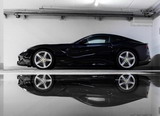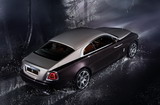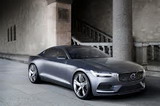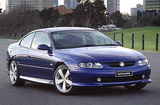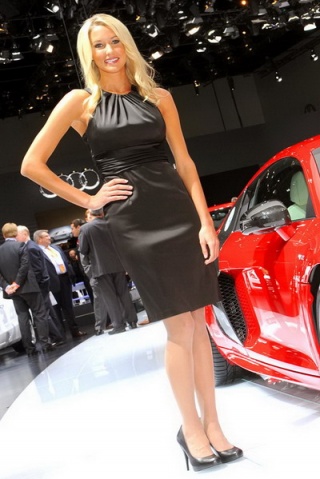Jaguar XKR
INTRODUCTION
Jaguar is proud to reveal its new supercharged sports car – the Jaguar XKR. Building on the excellence of the all-new XK that debuted in 2005, the XKR takes the Jaguar sports car experience to new heights.
Like the XK model, the new supercharged XKR makes intelligent use of practical, modern technology such as an industry-leading aluminium monocoque structure that results in a light and yet very stiff body. An uprated 420bhp (SAE) supercharged V8 engine and class-leading calibration of a state-of-the-art, six-speed automatic transmission deliver accessible, real-world, high performance that makes the XKR the most impressive sporting GT all-rounder in its class.
The XKR’s powerful statement of intent is emphatically reinforced by sporting styling cues such as an enhanced front bumper, bonnet louvres and aluminium-finish grilles and side power vents. Unique 19 and 20-inch alloy wheel designs and a quad-exhaust system add to the overall presence.
“The new supercharged XKR captures perfectly the essence of what makes a Jaguar XK so special,” commented Bibiana Boerio, Jaguar Cars’ managing director. “It is a perfect balance of refined Grand Tourer and serious performance sports car, that delivers a truly rewarding and exhilarating driving experience.”
New Jaguar XKR at a glance
• New supercharged Jaguar XKR sports car, available as a Coupe or Convertible
• All the attractions and attributes of the XK – but amplified in the ‘R’ to complement the extra power and performance
• 4.2-litre, supercharged V8 engine developing 420bhp and 560Nm of torque
• Coupe is capable of 0-60mph in 4.9 seconds, 50-70mph in just 2.5 seconds and has an (electronically limited) top speed of 155mph
• All-aluminium body construction delivers a lighter, stiffer car, with excellent agility. At 1665kg, the Coupe is 70kg lighter than its predecessor, while the 1715kg Convertible is 100kg lighter than the previous convertible XKR
• Prices start at £67,495 – a premium of just 12.5% over the XK. Available to order now
• Uprated springs and dampers and recalibrated Computer Active Technology Suspension (CATS) provide enhanced ride and handling
• Class-leading six-speed automatic transmission for ultra-quick manual gear shifts in milliseconds using steering-wheel-mounted ‘paddles’
• Active Exhaust System ensures refinement at cruising speed but purposeful V8 roar under hard acceleration
• Subtle XKR exterior styling enhancements include a sportier grille and front bumper design, louvred bonnet, aluminium-finish side power vents and two new wheel designs
• Enhanced interior includes unique aluminium ‘weave’ design on the fascia (other veneers such as polished burr walnut are available at no extra cost) and XKR sports seats
• Blend of supercharged performance, outstanding dynamic abilities and keen pricing gives the new XKR significant advantages overall against both lesser – and considerably more – expensive rivals
• In summary, the epitome of a contemporary Jaguar Grand Touring sports car and a perfect illustration of the marque’s philosophy of building beautiful, fast cars

DRIVING DYNAMICS
Driving the new XKR – exhilaration redefined
The new 420bhp (SAE) Jaguar XKR is a truly rewarding car to drive. With 120bhp (SAE) more power than the normally aspirated 4.2-litre XK and the same strong and stiff aluminium body structure, superb ride and handling is assured. Furthermore, a six-speed automatic transmission with Jaguar Sequential Shift that is regarded as class-leading in terms of speed and refinement ensures Jaguar’s blend of performance and dynamics reaches new heights with the XKR.
“Our aim when engineering the new XKR was to ensure that the car’s characteristics remained in balance despite the significant increase in power over the XK,” explains Jaguar’s chief engineer, Mike Cross. “Working with that as our base, our brief was to create ‘XK plus 30%’ – the ultimate sports GT for the real world.
“We wanted the performance and dynamism you would expect of an XKR but were careful to retain that exceptional blend of sporting luxury that every Jaguar must have and which is so convincingly demonstrated with the XK. The bottom line is that if you like the XK, you’ll absolutely love the new XKR.”
The result of that engineering brief is a car that performs vigorously in any conditions, at any speed. With superb torque at low engine speeds, instant acceleration is always available should you demand it. Similarly, the advanced steering and suspension set-up means the new XKR switches effortlessly from relaxed GT to honed sports car with ease. It is everything the XK is and much more besides. 
Supercharged 4.2-litre engine
Impressive reserves of power and acceleration available in an instant are the hallmark of every great Jaguar. The new XKR ensures this by using a supercharged version of Jaguar’s renowned 4.2-litre AJ-V8 engine. Producing 420bhp (SAE) at 6250rpm and 560Nm (EEC) of torque at 4000rpm, it is capable of propelling the XKR Coupe to 60mph in 4.9 seconds (5.0 seconds for the Convertible) and on to an electronically limited top speed of 155mph (250kph).
The addition of a supercharger and twin air intakes means the new XKR benefits from a 120bhp (SAE) power increase over the normally aspirated 4.2-litre XK with which it shares its base engine. Torque, so essential for instant acceleration at any engine speed, also increases significantly – by 36% over the XK. The overall weight of the XKR is raised by just 70kg, consequently the power-to-weight ratio compared to the normally aspirated 4.2-litre XK is an impressive 34% higher.
And in comparison to the previous generation XKR, the new engine produces more power and more torque. Combined with a significantly stiffer and lighter aluminium monocoque body structure, these performance improvements lead to a significant leap in the power-to-weight ratio of 12% and an equally useful jump of 7.7% in the torque-to-weight ratio. To achieve the equivalent improvements in power- and torque-to-weight in the outgoing XKR would have required nearly 50 more horsepower.
Among the benefits of the increases in power and torque are a Coupe 0-60mph sprint time reduced by 0.3 seconds compared to the previous XKR and acceleration from 50mph to 70mph in just 2.5 seconds.
At the heart of these significant performance improvements is the XKR’s lightweight eight-cylinder engine with an Eaton supercharger. The water-cooled cylinders are arranged in a 90-degree V configuration and the crankshaft is supported by five main bearings. Each of the two cylinder head assemblies incorporates twin camshafts operating four valves per cylinder. One of the reasons for the engine’s impressive output is continuously variable valve timing which helps to deliver a wide spread of torque. The engine uses an Electronic Return-less Fuel System (ERFS) and a three-way catalyst exhaust system for lower emissions.
The increase in power and torque over the outgoing XKR is down to two significant additions to the engine. The air intake has been significantly enhanced thanks to the use of twin air inlets, and a Variable Inlet Camshaft Timing (VICT) system is used for the first time on the XKR. By continuously adjusting the timing of the inlet camshaft on both banks of the V8 depending on the engine speed and load, Jaguar’s engineers have ensured significant improvements in torque, particularly at lower revs.
The VICT system is controlled by Engine Management System (EMS) which receives engine speed, throttle position and oil temperature data from its sensors. The EMS determines the correct inlet camshaft timing by continuously referring to a digital three-dimensional map developed to provide optimum performance. The EMS then transmits the appropriate signals to two solenoids that control the degree of hydraulic force provided to the valve actuators.
Another separate characteristic that the XK has been praised for is its acoustic quality, remaining unobtrusive and relaxed at modest speeds but producing an unmistakeable V8 ‘soundtrack’ when worked hard. On the XKR, the presence of supercharger whine threatened to dominate the acoustic character and mask the underlying sound quality. However, through enhancements to the vehicle acoustic pack, the supercharger noise has been reduced by 5dB compared to the previous XKR eliminating any potential issue.
This approach to acoustics allowed engineers to concentrate on using the exhaust system to deliver the best possible sound quality character. This was accomplished through the use of the XKR’s Active Exhaust which varies the flow of exhaust gases through the main silencer box to ensure that the XKR remains quiet at cruising speeds but delivers a substantially more purposeful V8 roar under hard acceleration.
Transmission
Jaguar Sequential Shift combines all the speed and involvement of a sequential manual gearbox with the comfort and convenience of a full automatic. The system consists of steering wheel-mounted paddles and a conventional automatic gearlever, allowing the driver to switch between three automatic or paddle-operated transmission modes.
Whereas an automated manual gearbox interrupts the flow of torque during the gearchange – while the clutch is disengaged – Jaguar's transmission maintains the flow of torque throughout the shifting process. This results in gearchanges that are not only very quick, but also remarkably smooth. Gearshifts are achieved in less than 600 milliseconds, from the point at which the driver operates the shift paddle to the point at which the shift is completed.
In fact, during development, comparison tests between Jaguar Sequential Shift and rival automatic transmissions in the class showed the transmission to be the fastest system of all, changing gear at least 400 milliseconds faster than a standard automatic and 100 milliseconds faster than the best automated manual system.
The three gearbox modes give the driver total flexibility to use the transmission to match whatever driving style he or she chooses. In Drive mode, the gearbox behaves as a conventional automatic, with the software optimised for everyday driving conditions and providing all the benefits of a best-in-class automatic transmission.
In Sport mode, the gearbox's adaptive software becomes more prevalent, adapting and reacting more dynamically to demanding conditions. This software takes account of the prevailing road conditions and driver's inputs and adapts accordingly. For example, it recognises when the car is negotiating a curve, and holds the gear accordingly; Hill Recognition enables the XKR to choose the ratios to optimise the ascent or descent of a hill; the gearbox’s software will also match the engine speed precisely to the engine and road speeds, ‘blipping’ the throttle during rapid downshifts.
Manual mode is activated by simply operating one of the steering wheel-mounted paddles, and delivers a state-of-the-art manual gear shift feel from the automatic transmission. 
CHASSIS, SUSPENSION AND BRAKES
To ensure optimum sporting ride and handling the XKR’s springs and dampers are uprated compared to the XK. The front spring rate is increased by 38% and the rear spring rate by 24%. Allied to the Servotronic steering system, which has been tuned both mechanically and electronically to give the steering more weight and even greater response, the uprated suspension ensures confidence-inspiring handling without any loss in refinement and comfort levels.
Because of the inherent strength and stiffness of the chassis, and the addition of a rear suspension brace engineered to accommodate the significant increase in rear spring rate, the XKR Coupe and Convertible have the same dynamic settings.
The Computer Active Technology Suspension (a two-stage adaptive damping system that ensures the optimum balance between ride and handling) and new switchable Dynamic Stability Control with Traction Control System (Trac DSC) have also been recalibrated to complement the additional power of the supercharged engine.
As significant to the XKR as the increases in power and torque are the major improvements in body stiffness, strength and weight compared to its predecessor. Unique in the industry for being a volume production complete aluminium monocoque body structure, as distinct from an aluminium spaceframe with separate aluminium exterior panels, its properties come from both the way the bodyshell is designed and constructed and the use of new joining technologies.
The new XKR’s aluminium chassis is significantly lighter and stiffer in both Coupe and Convertible form than the steel model it replaces. The Coupe chassis is more than 30 percent stiffer than the previous XK, while the Convertible is over 40 percent stiffer. As a consequence the XKR accelerates faster than the previous model, while offering high levels of safety, reduced noise and vibration intrusion, and improved ride and handling characteristics thanks to improved suspension dynamics. In Convertible form the BIW weight, at just 287kg is 19 percent lighter than the previous XKR. 
New, larger ventilated brake discs at the front ensure even better braking performance for the XKR. The front brake disc diameter has increased from 326mm to 355mm and the thickness from 30mm to 32mm, which not only improves braking but also the system’s resistance to fade. The braking system also includes four-channel ABS, Electronic Brake Force Distribution, Hydraulic Brake Assist to increase brake pressure during an emergency stop, and Jaguar’s Electronic Park Brake function.
Design
With the much-admired new XK already receiving considerable praise, Jaguar’s creative team, led by Ian Callum, had a great starting point from which to produce the XKR. The XK’s elegant form draws on the lineage of the original XK and E-type sports cars, and by blending this unmistakeable Jaguar silhouette with contemporary flair its exterior forms a stunning blend of athleticism and definition. The XKR now takes this athletic look one stage further thanks to the addition of:
• New XKR front bumper with colour-keyed finish on front fog lamp housings
• Aluminium finish side power vent
• Bonnet louvres and unique ‘XKR’ aluminium finish to upper and lower front mesh grilles
• Aluminium finish to rear ‘signature blade’ and selected exterior trim
• Unique to XK 19 and 20-inch alloy wheels. ‘Jupiter’ design 19-inch wheels as standard and 20-inch ‘Cremona’ XKR wheel available as an option
• Black brake callipers with ‘R’ logo
• Quad exhaust system and revised lower bumper
• ‘R’ rear badge
Jaguar Design Director Ian Callum explains the thinking behind the look of the new XKR:
“We talk at Jaguar of how our new generation of models are ‘beautiful, fast cars’. It’s a phrase that sums up our brand and can be applied to every car we design. We were extremely proud of the reaction to the new XK when it was unveiled last year – it is as beautiful as you would expect a Jaguar sports car to be. Now the new XKR has a look that emphasises the ‘fast’ aspect of our design statement.
“The ‘powerline’ that runs from the front wheel through the cabin area and into the car’s rear haunches remains and we have added to that latent feeling of power by adding some strong performance features such as the louvres that signify the potent supercharger and the stunning new alloys that fill the wheel arches and give the car real purpose.”
The new XK’s interior design has been just as highly praised and the XKR’s cabin represents a truly sophisticated yet driver-focussed environment. The XKR has class-leading ergonomics, user-friendly in-car technology and simple, clear information displays in the instrument panel and main dashboard area.
A unique sports seat design with additional lateral support for both the driver and front seat passenger has been created, with an ‘R’ badge on the headrests, tachometer, steering wheel and gear selector. The design of the standard aluminium interior trim is also unique to the XKR, featuring a ‘weave’ pattern from the Advanced Lightweight Coupe design concept that was first shown at the 2005 North American International Auto Show.
XKR customers can also specify the Luxury Sports interior option which features softgrain leather on the 16-way adjustable seats, instrument panel, door trim and centre console.
THE XKR MARKETPLACE
Like the XK, the new XKR competes within the Large Premium Sport (LPS) sector. In 1999 this sector accounted for just under 50,000 sales per year worldwide. Since that time it has doubled in size.
The XKR will appeal to a select group of affluent customers, who have an affinity with luxury products. They are looking for a GT as well as a car with pure sporting credentials; one that provides exhilaration and escapism combined with status and exclusivity – ‘luxury in a sports skin’ is one way to describe it.
The new XKR, like all Jaguars, offers excellent value for money – especially in the LPS sector. With prices starting from £67,495, the supercharged XKR ensures customers will enjoy a considerable increase in performance over the normally aspirated XK for a relatively small price premium. They will also benefit from significant advantages over rivals – the Mercedes-Benz SL500, for example, is heavier and slower to accelerate than the XKR, despite costing more. And the combination of an advanced lightweight body structure, powerful engine and true sports car agility also gives the XKR capabilities close to much more expensive out-and-out performance models.
SUMMARY
When the new XK was unveiled in 2005 it pushed back the boundaries of GT sports car motoring. Now the supercharged XKR extends those boundaries even further. The most potent of all Jaguar’s beautiful, fast cars effortlessly straddles the gap between out-and-out performance supercars that struggle to cope with everyday use and more sedate grand tourers that are hampered by excess weight.
Now customers can purchase a car capable of hitting 60mph in less than five seconds, which handles like a thoroughbred sports car, yet still offers high levels of comfort, style and craftsmanship. And the new XKR also represents remarkable value for money, with a power increase of over 25%, yet an increase of just 12.5% in terms of price compared to the normally aspirated 4.2-litre XK.
Like every great Jaguar, the XKR combines beauty with power, and style with dynamism, delivering a blend of performance and luxury that is quite simply exceptional.
JAGUAR XKR - TECHNICAL SPECIFICATION
COUPE CONVERTIBLE
CHASSIS Riveted and bonded aluminium Riveted and bonded aluminium
ENGINE
Cylinders/valves per cylinder 8/4 8/4
Bore/stroke – mm 86/90.3 86/90.3
Capacity – cc 4196 4196
Compression ratio 9.1:1 9.1:1
Maximum power – SAE bhp (kW) 420 (313) 420 (313)
EEC PS (kW) 416 (306) 416 (306)
@ rpm 6250 6250
Maximum torque – EEC lb ft (Nm) 413 (560) 413 (560)
@ rpm 4000 4000
Transmission 6-speed automatic. 6-speed automatic.
Jaguar Sequential Shift Jaguar Sequential Shift
with steering wheel-mounted with steering wheel-mounted
shift paddles shift paddles
Gear ratios 1st†† 4.171 1st†† 4.171
2nd† 2.340 2nd† 2.340
3rd†† 1.521 3rd†† 1.521
4th†† 1.143 4th†† 1.143
5th†† 0.867 5th†† 0.867
6th†† 0.691 6th†† 0.691
Final Drive 3.31:1 Final Drive 3.31:1
(Overall gearing is 8% shorter than the outgoing XKR series)
PERFORMANCE (Manufacturer’s figures)
0-60 mph (0-100 kph) - seconds 4.9 (5.2) 5.0 (5.3)
50-70mph – seconds 2.5 2.6
1/4 mile – seconds 13.3 13.4
Top speed – mph (kph) 155 (250) electronically limited 155 (250) limited
AERODYNAMICS
Cd 0.341 0.359
STEERING
Ratio 17.1:1 17.1:1
Turns lock-to-lock 2.77 2.77
Turning radius
(kerb to kerb) – m (feet) 10.97 (33.4) 10.97 (33.4)
FUEL ECONOMY1
Combined – mpg (l/100km) 22.9 (12.3) 22.9 (12.3)
CO2 Combined – g/km 294 294
Fuel tank – l 71.1 71.1
WEIGHT/DIMENSIONS
Kerb weight – lb 3671 3781
Kerb weight – kg 1665 1715
Weight Distribution – Fr/Rr % 53.4/46.6 52.8/47.2
Length – mm 4791 4791
Width – mm 1892 1892
Height – mm 1322 1329
Wheelbase – mm 2752 2752
Front/rear track – mm 1560/1608 1560/1608
WHEELS/TYRES
19-inch wheels Front: 245/40R19 Front: 245/40R19
Rear: 275/35R19 Rear: 275/35R19
20-inch wheels Front: 255/35R20 Front: 255/35R20
Rear: 285/30R20 Rear: 285/30R20
